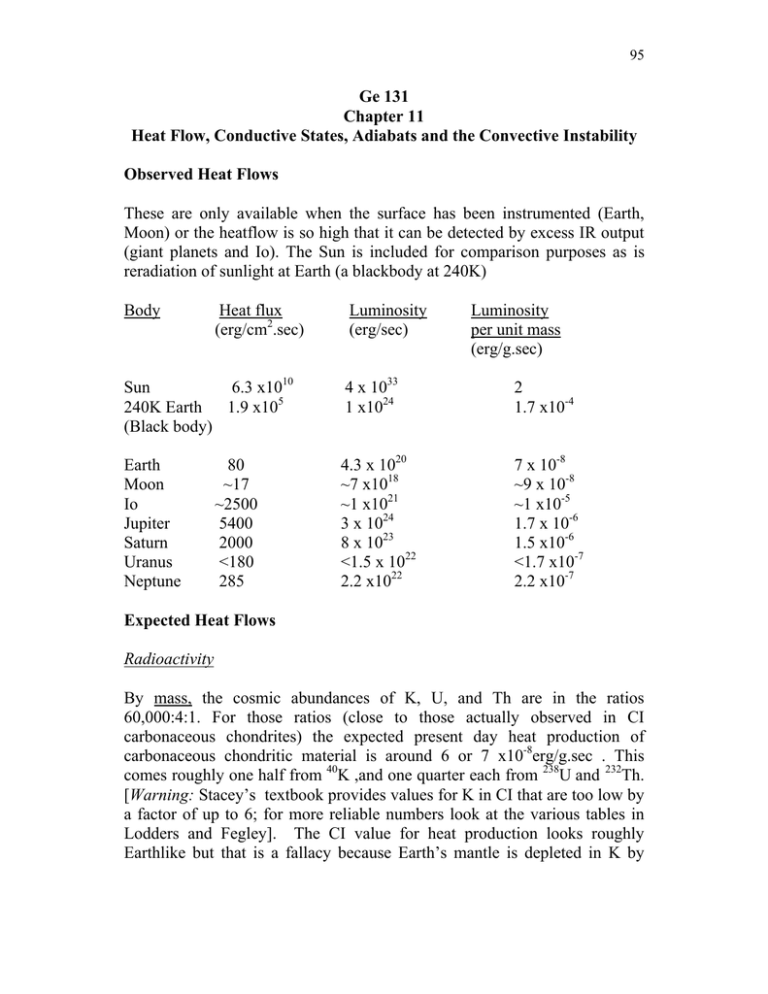Ge 131 Chapter 11 Observed Heat Flows
advertisement

95 Ge 131 Chapter 11 Heat Flow, Conductive States, Adiabats and the Convective Instability Observed Heat Flows These are only available when the surface has been instrumented (Earth, Moon) or the heatflow is so high that it can be detected by excess IR output (giant planets and Io). The Sun is included for comparison purposes as is reradiation of sunlight at Earth (a blackbody at 240K) Body Heat flux (erg/cm2.sec) Luminosity (erg/sec) Luminosity per unit mass (erg/g.sec) Sun 6.3 x1010 240K Earth 1.9 x105 (Black body) 4 x 1033 1 x1024 2 1.7 x10-4 Earth Moon Io Jupiter Saturn Uranus Neptune 4.3 x 1020 ~7 x1018 ~1 x1021 3 x 1024 8 x 1023 <1.5 x 1022 2.2 x1022 7 x 10-8 ~9 x 10-8 ~1 x10-5 1.7 x 10-6 1.5 x10-6 <1.7 x10-7 2.2 x10-7 80 ~17 ~2500 5400 2000 <180 285 Expected Heat Flows Radioactivity By mass, the cosmic abundances of K, U, and Th are in the ratios 60,000:4:1. For those ratios (close to those actually observed in CI carbonaceous chondrites) the expected present day heat production of carbonaceous chondritic material is around 6 or 7 x10-8erg/g.sec . This comes roughly one half from 40K ,and one quarter each from 238U and 232Th. [Warning: Stacey’s textbook provides values for K in CI that are too low by a factor of up to 6; for more reliable numbers look at the various tables in Lodders and Fegley]. The CI value for heat production looks roughly Earthlike but that is a fallacy because Earth’s mantle is depleted in K by 96 about an order of magnitude relative to CI. There is no reason to suppose that Earth’s core contains large amounts of potassium; the depletion is more reasonably attributable to volatility. (Other elements of similar volatility to K are also depleted in Earth and there is no expectation that they would go into the core). Consequently, Earth’s energy output is believed to be roughly a factor of two larger than that due to radioactivity alone. Moon’s heat flow is too poorly determined to yield to any useful analysis. It may be anomalously high in the places measured (or just very poorly measured). Note two important things about radioactive heating: First, that it will scale as the mass of the planet (which means that the surface heat flux will scale roughly as mass over area or, equivalently, radius.) So Mars would have a factor of two lower heat flux than Earth (all else being equal, which it isn’t!) Second, radioactive heat decays with time so the heat flow should be much larger in the early history of the planet. For Earth, radioactive heating should be about four times larger in early history (with 40K and 235U playing major roles). Clearly, none of the heat flows measured in the outer solar system can be attributed to radioactivity, especially when you consider that the mass of these bodies (except Io) is dominated by material (H, He, C, N, O) that contains no radioactive elements. Secular Cooling Suppose a planet has cooled by an amount ∆T over 4.5 billion years. If it has a mean specific heat Cv, then the expected luminosity per unit mass, L/M, is obviously Cv∆T/(4.5 x109yr) which is: L/M = (7 x 10-8 erg/g.sec).(Cv/1 x107cgs). (∆T/103K) For Earth, this will be significant, or even dominant for cooling rates of ~200K/billion years. For Jupiter and Saturn where the specific heat is ~2 x108 cgs (because of the low molecular weight), the observed luminosity can be explained for total cooling of a few thousand degrees (though, as we shall see, the cooling may be fast early on). Neptune could also be explained with ~1000-2000K cooling and an ice-dominated specific heat (Cv ~ 2 x107). 97 Differentiation If some fraction x of a planet settled to the bottom and was ~twice as dense as mean density then you might expect the total energy release to be ~xGM2/R. Averaged over 4.5 x 109 yrs, one then has L/M ~1 x10-4x for Jupiter and ~3 x 10-5x for Saturn, so this could easily be important. For Earth, one gets ~4 x10-6x, which could be important but there is no current differentiation that would yield significant x (core formation was early in Earth’s history). Tides This is special to Io and Europa (and maybe for part of Ganymede’s history) but has to be evaluated on an individual basis because it is sensitive to orbital parameters as well as material properties. The Conductive (or Radiative) State We can use our knowledge of plausible planetary materials to pose the following question: What would the thermal state be inside a planet, were the heat to be carried by microscopic (i.e. conductive or radiative) processes alone? (This is a separate but related question to the one we discussed earlier of whether there is sufficient time to set up a steady state that depends on microscopic transport.) A. Terrestrial Planets The typical thermal conductivity of mantle rocks and crust is around 3 x105 erg/cm.s.K. This means that for a heat flow F, the increase of temperature with depth z is given by: dT o F(erg / cm 2 .s) ( K / km) ≈ dz 3 which implies a temperature gradient of 20K/km or even more with depth for Earth. Even on the Moon, one gets 5 or so K/km. On Earth, this 98 temperature gradient leads to a temperature at depth D(in km) of around 300+20D, which exceeds the melting point (about 1600K) at about 65 km. But we know that earth is not pervasively molten at this (or any mantle) depth! We know this from seismology. You can reduce but not eliminate the problem by arguing that the heat sources are concentrated near the surface (so that the temperature profile is not linear). However, this cannot solve the problem because we know the radioactivity of mantle rocks (from xenoliths) and it provides a large fraction of the heat flow. So the conclusion for Earth (and by plausible extension other large terrestrial bodies) is that the heat cannot get out entirely by conduction. It is less clear for the Moon. In Io, the implied temperature gradient is even greater, but clearly most of the heat gets out volcanically (i.e. by magmatic eruptions and lava flows). For example, you can explain 2500 erg/cm2.sec, by the delivery of ~3 x1010 erg/cm3 (the expected heat content of magma) at a mean “velocity” (i.e., resurfacing rate) of ~2cm/yr (= 7 x 10-8 cm/sec). B. Giant Planets The situation here is far less straightforward. First, consider the deep atmosphere. These bodies are dominated by molecular hydrogen, which also usually provides the dominant opacity source through pressure-induced absorption. The property of pressure-induced absorption is that the opacity is proportional to pressure. Now the heat flow carried by radiation can be written in the form Frad ≈ d(σT4)/dτ where the increment in optical depth is dτ = -ρκdr and κ is the opacity. (This equation should be intuitively obvious to order of magnitude since the photons go one optical depth before being absorbed). Optical depth is dimensionless and here defined to decrease as one goes outwards, so an optical depth of one corresponds to the place from which photons escape to space. This predicts that if radiative transport dominates, then T ~ Teτ1/4 where Te is the temperature at optical depth unity (measured from the outside inwards). From hydrostatic equilibrium, dp/dr = -ρg and the definition of optical depth, we have dp/dτ = g/κ. But in molecular hydrogen, the opacity is roughly proportional to pressure and so integrating, we have p~ τ1/2 and 99 constancy of Frad then implies T ~ p1/2. This is a stronger dependence than the increase of temperature along an adiabat. Radiative transport in molecular hydrogen would therefore require that the entropy decrease with height. As we see below, this leads to a convective instability. [Note: This argument may break down around T~1000K where molecular hydrogen becomes somewhat transparent. In other words, the opacity does not just depend on pressure it also depends on the wavelengths of the thermal photons involved, or equivalently on temperature. Tristan Guillot has studied this in detail.] Deep within the planet, the highest thermal conductivity you can find is that attributable to metallic hydrogen. This is certainly less than 109 erg/cm.s.K. Even for this upper bound, the observed heat flow would lead to a temperature gradient of 0.3K/km, implying a temperature increase of around 20,000K for a radial range of 60,000 km. As we shall see, this is unstable. The situation in dense molecular hydrogen is much worse... a thermal conductivity of perhaps 107erg/cm.s.K and a conductive gradient of around 30K/km, implying ridiculous temperature increase with depth. In all planets, the conductive profiles are usually convectively unstable. To understand this, we need some fluid dynamical background. A Fluid Dynamical Preliminary In all fluid dynamics, we are principally interested in understanding the solutions of the well-known equation F = ma where F is the force, m is the mass and a is the acceleration. Of course, we are usually interested in continua rather than discrete masses, so we more commonly write this equation in the form a = f/ρ where f is the force per unit volume and ρ is the mass density (mass per unit volume). It is common (but not essential) to choose a fixed coordinate grid and talk about the acceleration of the medium at a grid point. As time progresses, the material flows pass any given grid point. However, a is by definition the acceleration of an element of material that happens to be at a 100 given grid point at a given time . Accordingly, it is not merely the time rate of change of velocity at that point, but must include the usual advection term: a = dv/dt = ∂v/∂t + (v. )v where d.../dt is called the convective derivative and is the derivative in the comoving frame of the fluid element. The greatest richness of phenomenology lies in the contributions to f, the force acting on a unit volume of the medium. These contributions are of two kinds: body forces and surface forces. As the words imply, a body force is one that acts throughout the elementary volume, while a surface force is the sum of external forces acting on the element due to adjacent elements. The archetypal body force is gravity; the archetypal surface force arises from a pressure or stress gradient . Let's write the total force in the form f = fb + f s representing body and surface forces respectively. Gravity is by far the largest body force in situations of interest to us, though as we shall see nearly all of it is hydrostatically balanced and thus not of dynamical interest. So we have fb = ρg The surface force has a form that depends on the constitutive law of the medium: is it elastic, or plastic or viscous or what? This is a major issue, but for now we will assume a simple linear viscous model: σij = -p δij + η (∂ui/∂xj + ∂uj/∂xi) fs =div(σij) where σij is the stress tensor, p is the pressure, δij is the Kroeneker delta (0 if i ≠ j; 1 if i = j), and η is the dynamic shear viscosity (Poise in cgs units 101 and Pa.s in SI units). Actually, this is not the most general linear viscous model, since it includes only shear viscosity. If there is no fluid flow, then fb + fs =0; fb = ρg and fs =- p, so the solution is p = ρg which is, of course, the equation of hydrostatic equilibrium. Now here's an interesting thing: This equation does not have a solution for all possible density distributions. To see this, take the curl 0= ρxg where I have made use of the fact that x g = 0, (because g = φ , where φ is the gravitational potential ). This equation will not be satisfied if there is any variation of the density on an equipotential surface. As we shall see later, it is precisely such a variation that drives convection and many other dynamical flows. The equation of motion is never enough to fully characterize the flow. Several other ingredients are needed, one of which is the equation of continuity. It expresses a very simple statement physically: The mass of material in a unit volume changes according to the net flux of mass into that volume: ∂ρ/∂t = - (ρu) It is often adequate to adopt the incompressible flow assumption, in which .u = 0 If we assume incompressibility for the viscous response, then the equation of motion becomes du/dt = - p/ρ + g + ν∇2u where ν ≡ η/ρ is the kinematic viscosity and has units of a diffusivity (e.g. cm2/sec.) It has been assumed here that η is independent of position. 103 Taking yet another curl (i.e. ikx...) and remembering that k.u=0 (incompressibility), we get: r r r rr ( + k 2 )k 2u = −[k 2 g − k (k .g)](uz / ) Finally, we take the z-component of this (remembering that the vector g is in the negative z-direction) and we get: ( + k 2 ) = g (k x2 + ky2 )/ k 2 which has growing solutions for all choices of the wavevector, provided β>0. A. The Inviscid Limit In this limit, σ >> νk2, the viscous term is ignored and we get ≈ g . This has a simple mechanical explanation. If we have an element that has been displaced a distance z vertically then it feels a force which accelerates it at gβz, so the equation of motion becomes d2z/dt2 = gβz, which has a solution like exp(σt) with σ = (gβ)1/2. As an example, a 10% variation in density over 1000km (which means β=10-9 cm-1) gives an e-folding time for the instability of 103 seconds for Earth... very fast! It follows that unstable density gradients in low viscosity fluids on planets (atmosphere, ocean core) relax to small values. Of course, negative gradients cause oscillations (imaginary values for sigma). B. The Viscous Limit In this limit, σ << νk2, and the solution becomes ≈ g k2 This is the Stokes flow limit in which the forces are balanced and the inertial term (du/dt) is negligible, as one can confirm by going back to the original equation of motion. As an example, for Earth (g ~103 cm/s2, β ~ 10-9 cm-1 which is a 10% change in 1000km, ν~1021 cm/s2, and k ~ 6 x 10-8 cm-1 which is a wavelength of 1000km) one gets a characteristic timescale (σ-1) of ~105 yrs. Note that in this case (unlike the inviscid case) negative values of the density gradient cause decay (negative sigma) rather than oscillation





